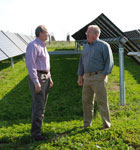There’s nothing new about Earth Systems performing environmental site assessments and non-destructive geophysical investigations; it’s been doing so for more than 40 years. What is relatively new, though, is its work for Tolosa Winery in San Luis Obispo, a place Earth Systems also calls home.
The vineyard had embarked upon a path toward sustainability, and the owners were keen to make use of California’s yearlong summery weather with the installation of a nearly 34,000-square-foot solar field to handle all of its electrical demands.
“The intent was for the installed system to provide the winery’s electrical energy for the next 25 years,” explains Craig Hill, president and CEO of Earth Systems. “They estimated that over the next 30 years the installed system would displace more than 32 million pounds of carbon dioxide—the equivalent of removing 2,600 cars from the road.”
“Over the next 30 years the installed system would displace more than 32 million pounds of carbon dioxide—the equivalent of removing 2,600 cars from the road.”
-Craig Hill, President & CEO, Earth Systems
Earth Systems, working in tandem with civil engineers hired by the vineyard, brought its understanding of the geological constraints of the local geography to bear upon the project.
“We understand what’s below the ground,” Hill says, “and we can identify what constraints there will be because of what’s down there. That allows us to make recommendations so that they can create a field that is going to be sustainable over the design life of the project.”
The team’s recommendations guided the placement of the field’s foundations and helped mitigate concerns about the local soil, which can be corrosive when in contact with certain metals.
“When you’re talking about a project that’s going to be sustainable over 25 years, you need to make sure that these external forces are brought under control so that it can survive,” Hill says. The soil concerns brought about various changes to the plans.
Since August 2009, Tolosa Winery has had SunPower’s 539-killowatt ground-mounted sun-tracking system in place. The trackers upon which the photovoltaic panels move use a GPS system to follow the path of the sun during the day, a functionality that can increase efficiency over a fixed collector by 20–30 percent.
In addition to the inevitable bout of wine-tasting upon completion of their role, Hill says the project and others like it interest Earth Systems as it undergoes its own program of improving its corporate sustainability.
“We’re intrigued by how we’re seeing the entire world change, which is a necessary change because as time goes on a lot of our natural resources are going to be impacted,” Hill says. “We’re excited to be a part of that and to contribute in any way that we can to the preservation of our global resources. We have to change as a company, but it’s not a bitter pill to make that change—it’s exciting, and there’s a ‘feel-good’ element … to being a part of the bigger picture of preservation.”

